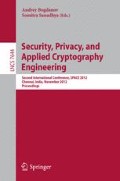Abstract
We consider the lossiness of RSA trapdoor permutation studied by Kiltz, O’Neill and Smith in Crypto 2010. In Africacrypt 2011, Herrmann improved the cryptanalytic results of Kiltz et al. In this paper, we improve the bound provided by Herrmann, considering the fact that the unknown variables in the central modular equation of the problem are not balanced. We provide detailed experimental results to justify our claim. It is interesting that in many situations, our experimental results are better than our theoretical predictions. Our idea also extends the weak encryption exponents proposed by Nitaj in Africacrypt 2012.
Access this chapter
Tax calculation will be finalised at checkout
Purchases are for personal use only
Preview
Unable to display preview. Download preview PDF.
References
Coppersmith, D.: Small Solutions to Polynomial Equations and Low Exponent Vulnerabilities. Journal of Cryptology 10(4), 223–260 (1997)
Fujioka, A., Okamoto, T., Miyaguchi, S.: ESIGN: An Efficient Digital Signature Implementation for Smart Cards. In: Davies, D.W. (ed.) EUROCRYPT 1991. LNCS, vol. 547, pp. 446–457. Springer, Heidelberg (1991)
Herrmann, M., May, A.: Solving Linear Equations Modulo Divisors: On Factoring Given Any Bits. In: Pieprzyk, J. (ed.) ASIACRYPT 2008. LNCS, vol. 5350, pp. 406–424. Springer, Heidelberg (2008)
Herrmann, M.: Improved Cryptanalysis of the Multi-Prime φ - Hiding Assumption. In: Nitaj, A., Pointcheval, D. (eds.) AFRICACRYPT 2011. LNCS, vol. 6737, pp. 92–99. Springer, Heidelberg (2011)
Howgrave-Graham, N.: Finding Small Roots of Univariate Modular Equations Revisited. In: Darnell, M.J. (ed.) Cryptography and Coding 1997. LNCS, vol. 1355, pp. 131–142. Springer, Heidelberg (1997)
Jochemsz, E., May, A.: A Polynomial Time Attack on RSA with Private CRT-Exponents Smaller Than N0.073. In: Menezes, A. (ed.) CRYPTO 2007. LNCS, vol. 4622, pp. 395–411. Springer, Heidelberg (2007)
Jochemsz, E., May, A.: A Strategy for Finding Roots of Multivariate Polynomials with New Applications in Attacking RSA Variants. In: Lai, X., Chen, K. (eds.) ASIACRYPT 2006. LNCS, vol. 4284, pp. 267–282. Springer, Heidelberg (2006)
Kiltz, E., O’Neill, A., Smith, A.: Instantiability of RSA-OAEP under Chosen-Plaintext Attack. In: Rabin, T. (ed.) CRYPTO 2010. LNCS, vol. 6223, pp. 295–313. Springer, Heidelberg (2010), http://eprint.iacr.org/2011/559
Lenstra, A.K., Lenstra Jr., H.W., Lovász, L.: Factoring polynomials with rational coefficients. Mathematische Annalen 261, 515–534 (1982)
Lenstra Jr., H.W.: Factoring integers with elliptic curves. Annals of Mathematics 126, 649–673 (1987)
May, A.: Secret Exponent Attacks on RSA-type Schemes with Moduli N = prq. In: Bao, F., Deng, R., Zhou, J. (eds.) PKC 2004. LNCS, vol. 2947, pp. 218–230. Springer, Heidelberg (2004)
Nitaj, A.: A New Attack on RSA and CRT-RSA. In: Mitrokotsa, A., Vaudenay, S. (eds.) AFRICACRYPT 2012. LNCS, vol. 7374, pp. 221–233. Springer, Heidelberg (2012)
Rivest, R.L., Shamir, A., Adleman, L.: A Method for Obtaining Digital Signatures and Public Key Cryptosystems. Communications of ACM 21(2), 158–164 (1978)
Schridde, C., Freisleben, B.: On the Validity of the Φ-Hiding Assumption in Cryptographic Protocols. In: Pieprzyk, J. (ed.) ASIACRYPT 2008. LNCS, vol. 5350, pp. 344–354. Springer, Heidelberg (2008)
Takagi, T.: Fast RSA-type Cryptosystem Modulo pkq. In: Krawczyk, H. (ed.) CRYPTO 1998. LNCS, vol. 1462, pp. 318–326. Springer, Heidelberg (1998)
Tosu, K., Kunihiro, N.: Optimal Bounds for Multi-Prime Φ-Hiding Assumption. In: Susilo, W., Mu, Y., Seberry, J. (eds.) ACISP 2012. LNCS, vol. 7372, pp. 1–14. Springer, Heidelberg (2012)
Author information
Authors and Affiliations
Editor information
Editors and Affiliations
Rights and permissions
Copyright information
© 2012 Springer-Verlag Berlin Heidelberg
About this paper
Cite this paper
Sarkar, S. (2012). Reduction in Lossiness of RSA Trapdoor Permutation. In: Bogdanov, A., Sanadhya, S. (eds) Security, Privacy, and Applied Cryptography Engineering. SPACE 2012. Lecture Notes in Computer Science, vol 7644. Springer, Berlin, Heidelberg. https://doi.org/10.1007/978-3-642-34416-9_10
Download citation
DOI: https://doi.org/10.1007/978-3-642-34416-9_10
Publisher Name: Springer, Berlin, Heidelberg
Print ISBN: 978-3-642-34415-2
Online ISBN: 978-3-642-34416-9
eBook Packages: Computer ScienceComputer Science (R0)

